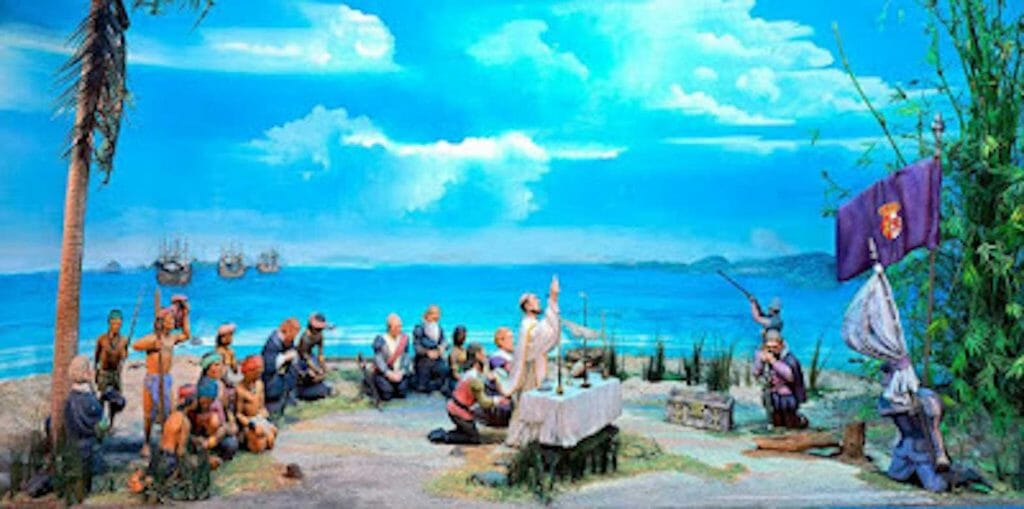
Occasion: First recorded baptism in the Philippines
Date: April 14, 1521. Date of 500 YOC in the Philippines (CBCP)
Place: Plaza Sugbo, beside the Basilica del Santo Niño, Cebu City
At this time of year, 501 years ago, the first evangelization happened and the first ever baptism was administered.
The Catholic Bishops’ Conference of the Philippines (CBCP) added one significant detail to the importance of this date, designating the first baptism in Cebu in 1521 as the reckoning date, the point of reference, of the 500 YOC in the Philippines.
From Leyte, where Fernão de Magalhães (Magellan) and his men celebrated the first Mass, they reached this exact site in Cebu where he instructed his soldiers to plant a large wooden cross. Magellan’s chronicler, Italian scholar Antonio Pigafetta, jotted down history, which was originally published in the Old Italian in 1525:
Posta la croce, ognuno disse uno Pater Noster e una Ave Maria, adorandola… “After the cross was erected in position, each of us repeated one OUR FATHER and one HAIL MARY, and adored the cross…”
First catechism
The ruler and the autochthonous people of Cebu were gathered together to hear for the first time the good news of salvation, a fulfilment of the mandate received from Christ: “Go into all the world and preach the gospel, baptizing them in the name of the Father and of the Son and of the Holy Spirit” (Matthew 28:19).
The Portuguese explorer, with Padre Pedro de Valderrama, had the honor of explaining to the natives the age-old Catechism of the Catholic Church. Magellan was the messenger and his Malaccan slave Enrique was the translator.
Pigafetta left no doubt as to the pleasure that Magalhães derived from delivering his first “sermons” to the attentive audience. In his own words that I roughly translated into English:
“The captain said many things about peace, and prayed that God would confirm it in heaven. The people said they never heard such glad tidings and that they took great pleasure in hearing them… He began to say things to bring them to faith.”
First, Magalhães preached, then Padre Valderrama baptized. Catechize or evangelize first before administering the Sacraments.
April 14, 1521
On this day, Rajah Humabon of Cebu, his heir, officials, consorts, and subjects were baptized after they heard the elementary catechetical lessons from the lips of Magalhães, Enrique, and Padre Valderrama. Humabon was christened Carlos in honor of Charles V, who was both the King of Spain (1516-1556) and the Emperor of the Holy Roman Empire (1519 to 1558).
Before noon, Padre Valderrama baptized around 500 men, after which Magalhães invited Humabon and his officials for lunch aboard the flagship, Trinidad. The chief of Cebu declined the invitation.
Magalhães gave Humabon’s chief consort and queen of Cebu, Hara Humamay, an image of the Santo Niño, the miraculous image considered to be the oldest Catholic relic in the Philippines.
The generous gift to the queen was accompanied by a soft whisper, that is, a friendly request to destroy all the idols and shrines that were associated with their past non-Christian practices. According to Pigafetta, Hara Humamay, upon seeing the image of the Santo Niño, “was seized with contrition, and weeping, asked for baptism.”
After lunch, baptism was held for women, including Hara Humamay and hundreds more. This is how Chronicler Antonio Pigafetta recorded the glorious day of the first baptism:
Battezzassemo ottocento anime fra uomini, donne e fanciulli. La regina era giovane e bella, tutta coperta d’uno panno bianco e nero: aveva la bocca e le onghie rossissime. “We were baptizing eight hundred souls among men, women and children. The queen was young and beautiful, all covered with a black and white cloth: her mouth and her nails were very red…”
Overall significance of the first recorded baptism
Unfortunately, the famed 1521 expedition story, including the romanticized narrative of the mass Baptism of the early natives, ended in tragedy.
Historian Danilo Gerona wrote that, at the Battle of Mactan, today’s Punta Engaño, the warriors of Lapu Lapu maimed and killed Magellan, and his body was taken as a trophy.
In a subsequent move, Rajah Humabon poisoned the remaining Spanish leaders of the expedition, Duarte Barbosa and João Serrão (Ferdinand Magellan: The Armada de Maluco and the European Discovery of the Philippines, 2016, Chapter 10).
But Pope Francis told us that you don’t forget the historical event of the first baptism just because it ended up in a tragedy.
The Holy Father said in his 2021 video message during the quincentennial anniversary of the arrival of Christianity in the Philippines that the Christian Faith started in the Middle East (Jerusalem), where Jesus mandated His Apostles to spread His mission of evangelization.
That Faith reached Europe in the first century and, in 1521, found its way to the Philippines. The Jesuit Pontiff urged Filipinos to keep going and share the gift of Faith they received 500 years ago.
Today, it’s been acknowledged that Filipinos play a key role in spreading Christianity to the world in the course of their employment as OFWs or migrant workers. The Holy Father reminded us that solemn mandate was given to us on April 7, 1521, during the first catechism and first baptism in the Philippines.
The Pontiff even appointed Archbishop Bernardito Auza, a Filipino, as Apostolic Nuncio to Spain, the country that gave us the Christian Faith.
“You know how to transmit the Faith and you do it well. You know how to celebrate the feast of Faith,” not as explorers or colonizers, but as overseas Filipino workers, Pope Francis concluded.
Dr. Jose Mario Bautista Maximiano is a Catholic scholar, public educator, management advisor, and the author of the Catholic Social Teachings in CONTEMPORARY Philippine History: 500 YOC (1971-2021), Volume Three (Claretian, 2022).

